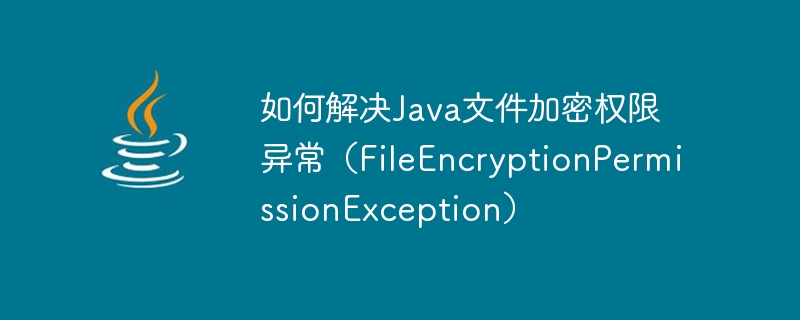

How to solve Java file encryption permission exception (FileEncryptionPermissionException)
Overview:
Java file encryption is a common method to protect file security, but sometimes it is in progress Permission exceptions may be encountered during file encryption operations. This article will introduce methods to solve Java file encryption permission exceptions and provide relevant code examples.
import java.io.IOException;
import java.nio.file.Files;
import java.nio.file.Path;
import java.nio.file.attribute.AclEntry;
import java.nio.file.attribute.AclFileAttributeView;
import java.nio.file.attribute.UserPrincipal;
public class FilePermissionChecker {
public static boolean hasPermission(Path filePath) {
try {
AclFileAttributeView aclView = Files.getFileAttributeView(filePath, AclFileAttributeView.class);
UserPrincipal currentUser = aclView.getFileSystem().getUserPrincipalLookupService().lookupPrincipalByName(System.getProperty("user.name"));
for (AclEntry entry : aclView.getAcl()) {
if (entry.principal().equals(currentUser)) {
return entry.permissions().containsAll(Files.readAttributes(filePath, "dos:encryption"));
}
}
return false;
} catch (IOException e) {
return false;
}
}
public static void main(String[] args) {
Path filePath = Path.of("C:/path/to/file.txt");
System.out.println("Has permission: " + hasPermission(filePath));
}
}import java.io.IOException;
import java.nio.file.Files;
import java.nio.file.Path;
import java.nio.file.attribute.FileAttribute;
import java.nio.file.attribute.UserPrincipal;
import java.nio.file.attribute.UserPrincipalLookupService;
public class FilePermissionElevation {
public static void main(String[] args) {
Path filePath = Path.of("C:/path/to/file.txt");
UserPrincipalLookupService lookupService = filePath.getFileSystem().getUserPrincipalLookupService();
try {
UserPrincipal user = lookupService.lookupPrincipalByName("username");
Files.getFileAttributeView(filePath, UserPrincipal.class).setOwner(user);
System.out.println("Permission elevated successfully.");
} catch (IOException e) {
e.printStackTrace();
System.out.println("Failed to elevate permission.");
}
}
} In the code, we use the getUserPrincipalLookupService method to get the user principal and then use setOwner Method changes the owner of the file to the specified user.
Note: Please make sure to run the program as an administrator or a user with sufficient permissions.
grant {
permission java.io.FilePermission "<<ALL FILES>>", "read, write";
}; In the code, we use the grant keyword and specify the permissions within curly brackets. The example here will allow reading and writing to all files.
Please note: For production environments, we should carefully consider security and set appropriate permissions.
Conclusion:
The above are some methods to solve the exception of Java file encryption permissions. When performing file encryption operations, it is very important to ensure that the user the program is running as has sufficient permissions to access the files. By checking file access permissions, elevating program running permissions, and checking and modifying Java security policy files, we can resolve permission exceptions and successfully perform file encryption operations.
I hope this article will help you understand and solve Java file encryption permission exceptions!
The above is the detailed content of How to solve Java file encryption permission exception (FileEncryptionPermissionException). For more information, please follow other related articles on the PHP Chinese website!
 The difference between Java and Java
The difference between Java and Java
 Advantages and Disadvantages of Free Overseas Website Servers
Advantages and Disadvantages of Free Overseas Website Servers
 How to read database in html
How to read database in html
 Introduction to the main work content of front-end engineers
Introduction to the main work content of front-end engineers
 mysql engine introduction
mysql engine introduction
 cdr file opening method
cdr file opening method
 What are the mysql update statements?
What are the mysql update statements?
 The most promising coin in 2024
The most promising coin in 2024




